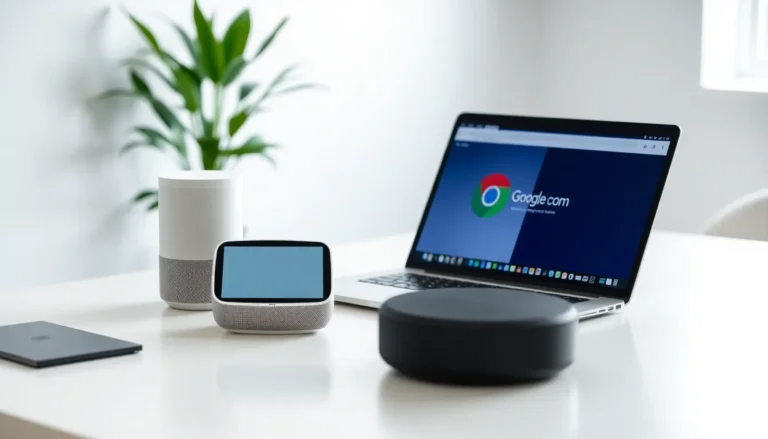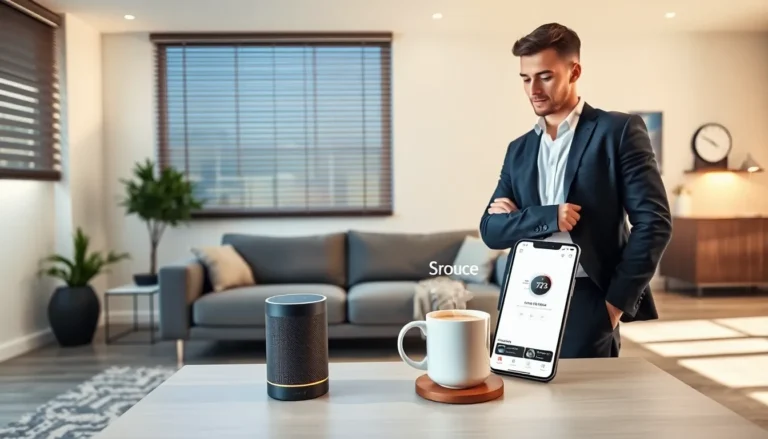Table of Contents
ToggleIn a world where even your toaster can be smarter than your average bear, smart home hubs have stepped into the spotlight. These nifty devices act as the brain of your home, connecting everything from lights to locks, and making life feel like a scene from a sci-fi movie—minus the flying cars, of course.
Overview of Smart Home Hubs
Smart home hubs serve as central control units for automated home systems. These devices link various smart appliances and systems, simplifying management of multiple devices from a single interface. Compatibility plays a crucial role, as hubs integrate with products from various manufacturers, enabling seamless communication.
Functionality encompasses device control, automation, and remote access. Users can adjust settings for lights, thermostats, and security systems, enhancing convenience and energy efficiency. For instance, a smart home hub allows users to set schedules, like turning off lights at midnight or lowering thermostats during the day.
Popular smart home hubs include Amazon Echo Plus, Google Nest Hub, and Samsung SmartThings. Each hub offers distinct features catering to different needs. The Amazon Echo Plus emphasizes voice control, while the Google Nest Hub provides a user-friendly touchscreen interface. Samsung SmartThings stands out by supporting a wide range of devices and local automation capabilities.
Security and privacy warrant attention, ensuring user data remains secure. Many smart home hubs encrypt data and allow users to set permissions for device access. Regular software updates enhance the overall security and functionality of these devices.
Installation varies by product, typically requiring a simple setup process. Users connect their devices to the hub via Wi-Fi or Bluetooth, following manufacturer instructions. Once set up, smart home hubs enable users to create routines and scenes, like a “Good Night” scene that turns off all lights and locks doors simultaneously.
Adapting to advancements in technology, smart home hubs continue to evolve. Features such as voice recognition and integration with artificial intelligence improve user experience, making home management more intuitive. Overall, smart home hubs significantly enhance connectivity and automation, consolidating control of smart devices for improved living.
Benefits of Using Smart Home Hubs
Smart home hubs offer essential advantages that enhance control and automation in modern living. Users experience greater convenience and efficiency with these devices.
Centralized Control
Centralized control simplifies managing multiple smart devices from one interface. Users adjust settings for various appliances without the hassle of navigating through numerous apps. Smart home hubs streamline interactions, making it easy to control lights, thermostats, and security systems in one place. Compatibility with a range of manufacturers’ products also eliminates concerns about integration. Smart home hubs eliminate the need for multiple remotes or apps, creating a seamless experience. This comprehensive control fosters efficiency, making everyday tasks more manageable.
Enhanced Automation
Enhanced automation features allow for customized routines and schedules. Users can set specific times for lights to turn on or off, enhancing security and energy savings. Smart home hubs enable automation across devices, coordinating actions that improve comfort and efficiency. For instance, a user might create a “Good Morning” routine that adjusts lighting, temperature, and coffee makers simultaneously. As technology evolves, these hubs incorporate learning capabilities, adapting to user preferences over time. Smarter automation maximizes convenience, transforming daily tasks into effortless experiences.
Popular Smart Home Hub Options
Several smart home hubs lead the market, each offering distinct features and integrations for users seeking convenience and efficiency.
Amazon Echo Plus
Amazon Echo Plus stands out with its built-in Zigbee hub, allowing connectivity without requiring additional devices. Users enjoy voice control through Alexa, enabling easy management of smart appliances. The device supports various brands and integrates seamlessly with products such as lights, thermostats, and security cameras. Enhanced audio quality ensures entertainment options are just a command away. Its alarm features, including reminders and notifications, further enhance home management. Regular software updates improve functionality, keeping users engaged and informed.
Google Nest Hub
Google Nest Hub excels in delivering a visually interactive experience, thanks to its touchscreen display. Users can control smart devices and access Google services effortlessly through voice commands. Compatibility with a broad range of smart home products facilitates streamlined connectivity. Integration with Google Assistant allows for personalized routines and schedules that adapt to user preferences. Users benefit from the ability to view recipes, watch videos, and control music playback from a single device. Enhanced security features, such as voice recognition, further protect personal data.
Samsung SmartThings Hub
Samsung SmartThings Hub serves as a versatile central control point for various smart home devices. Compatibility with devices from multiple manufacturers ensures users can integrate their existing appliances easily. Automation features enable the creation of custom routines that enhance daily living, adapting to users’ habits. The device supports Zigbee and Z-Wave protocols, allowing a wide range of connections. Offering remote monitoring, users can manage their homes while away, ensuring peace of mind. Its user-friendly app provides an intuitive interface for managing devices and monitoring activity.
Features to Consider When Choosing a Smart Home Hub
Smart home hubs feature essential attributes that influence user satisfaction and overall functionality. The following aspects warrant consideration when selecting a hub.
Compatibility with Devices
Compatibility with a wide range of devices matters most. A hub that integrates with major brands and technologies, like Zigbee and Z-Wave, ensures seamless communication between gadgets. Look for hubs that support both older and newer products to maximize flexibility. Many users prefer hubs with extensive partner ecosystems, allowing for easy additions of smart locks, lights, and cameras. Ultimately, the broader the compatibility, the more versatile the system becomes, enhancing the user experience.
User Interface and Usability
User interface design significantly impacts usability. Opt for hubs with intuitive dashboards and easy navigation, allowing users to set up devices effortlessly. Voice control options enhance user interaction, especially for those who prefer hands-free management. Responsive touchscreens, like those on Google Nest Hub, offer visual feedback, making controls straightforward. Customization options, such as creating routines or scenes, further elevate the usability, allowing users to tailor the interface to meet specific needs.
Security and Privacy
Security and privacy are critical considerations for smart home hubs. Look for devices that implement robust encryption to protect personal data during transmission. A hub that offers customizable privacy settings allows users to limit data sharing with third parties. Regular software updates ensure that security protocols remain current, safeguarding against potential vulnerabilities. Transparency regarding data collection practices is vital; users should know how their information is used and stored. Establishing these protective measures fosters trust and confidence in a smart home environment.
Smart home hubs are transforming the way people interact with their living spaces. By centralizing control of various devices they offer unmatched convenience and efficiency. Users can easily manage everything from lighting to security systems with just a few taps or voice commands.
As technology progresses these hubs are becoming more sophisticated. Features like voice recognition and advanced automation are enhancing the user experience and making homes smarter than ever. With a focus on compatibility security and user-friendly interfaces choosing the right hub can significantly elevate a home’s functionality.
Investing in a smart home hub not only simplifies daily routines but also paves the way for a more connected and efficient lifestyle. Embracing this technology can lead to a more comfortable and secure living environment for everyone.







